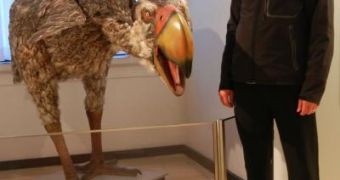Some 40-55 million years ago, a fierce-looking species of birds called present-day Europe its home. Oddly enough, it appears that, scary looks aside, these birds did not have a single bad bone in their body. Long story short, they were probably vegetarians.
The peculiar creatures, known to the scientific community as Gastornis or “terror birds,” measured about 2 meters (6.5 feet) in height, fossil evidence suggests.
They were unable to fly, and sported a fairly huge beak. Hence the fact that scientists have long assumed that they were ruthless carnivores that fed on whatever small mammals chanced to cross their path.
“The terror bird was thought to have used its huge beak to grab and break the neck of its prey, which is supported by biomechanical modelling of its bite force.”
“It lived after the dinosaurs became extinct and at a time when mammals were at an early stage of evolution and relatively small; thus, the terror bird was though to have been a top predator at that time on land,” Dr. Thomas Tütken at the University of Bonn explains, as cited by EurekAlert.
However, new evidence presented at the Goldschmidt conference in Florence, Italy this past August 29 suggests that, rather than being meat-eaters, these ancient birds were gentle herbivores.
A detailed analysis of Gastornis fossil remains has revealed that the makeup of these creatures' bones resembled that of herbivorous mammals and dinosaurs much more than it did that of top predators.
Thus, the calcium isotope composition in fossilized “terror bird” bones indicates that their diet largely comprised of plants, maybe even fruits.
To prove their theory that these ancient birds were not meat-eaters but herbivores, researchers wish to compare their remains to those of other creatures they shared their natural habitat with.
“We want to be absolutely confident in our findings by analyzing known herbivores and carnivores using fossilized bone from the same site and the same time period,” Dr. Thomas Tütken explains.
Hopefully, these tests will help solve the mystery surrounding the “terror birds'” dietary preferences.

 14 DAY TRIAL //
14 DAY TRIAL //